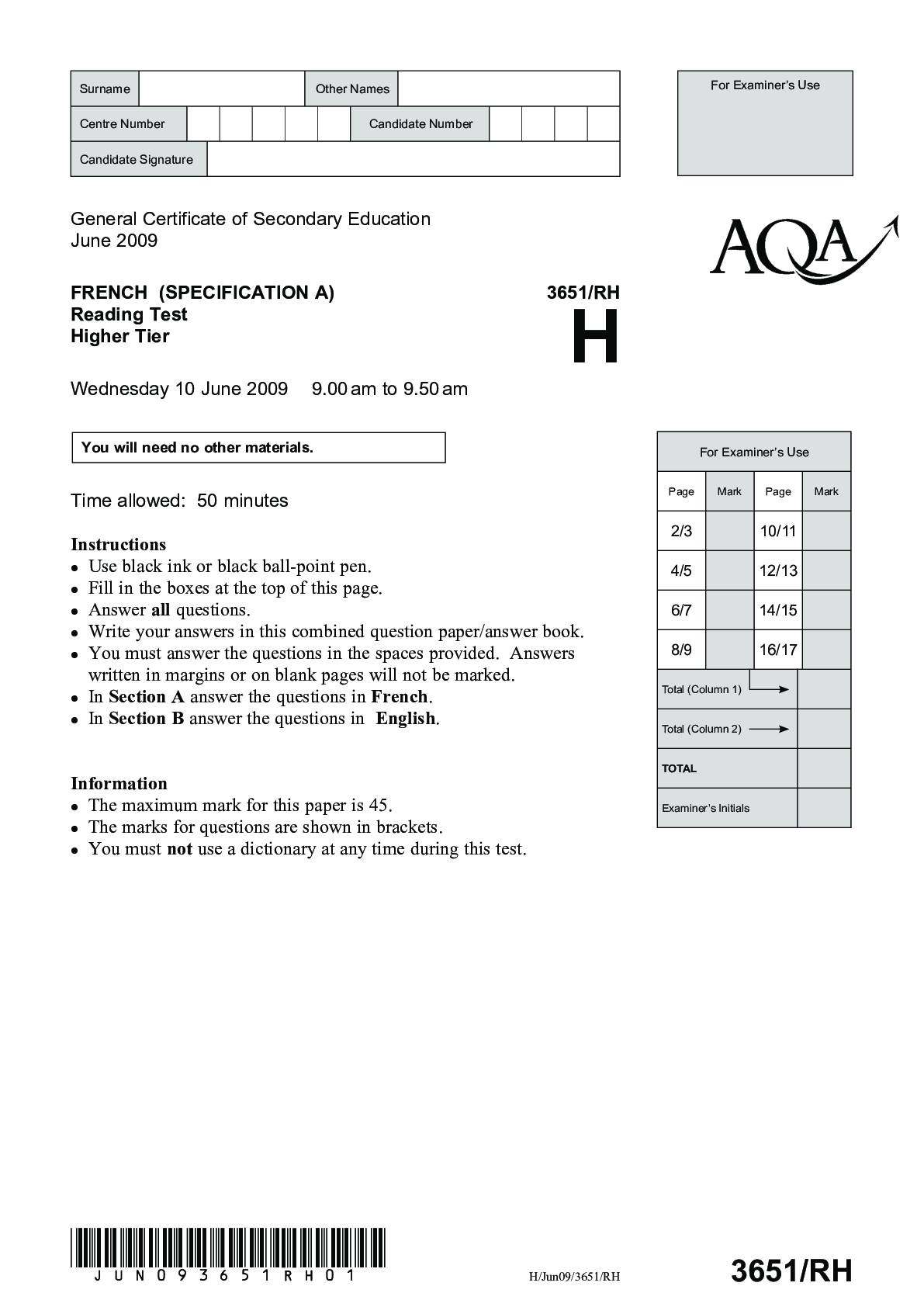Economics > EXAM > Cambridge International Examinations Cambridge International General Certificate of Secondary Educat (All)
Cambridge International Examinations Cambridge International General Certificate of Secondary Education * 7 5 0 5 7 2 8 4 2 0 * ECONOMICS 0455/21 Paper 2 Structured Questions May/June 2017, ECONOMICS 0455/22 Paper 2 Structured Questions May/June 2017,ECONOMICS 0455/23 Paper 2 Structured Questions May/June 2017 ( WITH MARK SCHEMES )
Document Content and Description Below
Cambridge International Examinations Cambridge International General Certificate of Secondary Education * 7 5 0 5 7 2 8 4 2 0 * ECONOMICS 0455/21 Paper 2 Structured Questions May/June 2017 2 hour... s 15 minutes No Additional Materials are required. READ THESE INSTRUCTIONS FIRST An Answer Booklet is provided inside this Question Paper. You should follow the instructions on the front cover of the Answer Booklet. If you need additional answer paper ask the invigilator for a Continuation Booklet. Section A Answer Question 1. Section B Answer any three questions. The number of marks is given in brackets [ ] at the end of each question or part question.2 © UCLES 2017 0455/21/M/J/17 Section A Answer this question. 1 The New Suez Canal In August 2015 the Egyptian Government opened a second Suez Canal, alongside the original canal, to enable more and larger ships to sail from the Mediterranean Sea to the Gulf of Suez. It cost more than US$8 billion to build, with land having to be purchased, capital equipment acquired and wages paid to the workers building the canal. This was at a time when there were calls for increased spending on healthcare, in particular improving the quality of public hospitals and improving education, especially adult literacy. The Egyptian Government believes that the canal will attract more ships, both those carrying goods and those carrying people. The number of goods and people using sea transport is influenced by a variety of factors. These include the speed of the transportation, the level of economic activity and the price of other forms of transport. Some goods have to be transported quickly, and recent years have shown how sensitive demand for sea transport is to recessions and economic booms. Fig. 1 shows how the market for sea transport has recently been affected by the change in the market for air transport. Q Q2 1 P 2 P 1 D 2 D 1 S O quantity of sea transport price of sea transport Fig. 1 The market for sea transport The Egyptian Government is hoping that new industries connected to the shipping industry will be built along the canal. Developing infant industries may help to reduce the country’s unemployment rate, which in 2015 was 12.5%. In 2015, the country had a population of 90 million, a population growth rate of 1.5% and a labour force of 28 million. Its death rate was falling. The government’s spending on healthcare was equivalent to 4% of Gross Domestic Product (GDP). 2015 also saw GDP at US$280 billion with an economic growth rate of 5%.3 © UCLES 2017 0455/21/M/J/17 [Turn over (a) Define ‘private cost’ and give an example from the extract. [2] (b) Explain opportunity cost and give an example from the extract. [4] (c) Calculate, using information from the extract: (i) the number of people unemployed in Egypt in 2015 [2] (ii) the amount the Egyptian Government spent on healthcare in 2015. [2] (d) Analyse how a global recession could affect demand for sea transport. [5] (e) Discuss whether a fall in a country’s death rate will always result in an increase in its population size. [5] (f) Explain, using information from the extract and Fig. 1, what happened to the market for sea transport as a result of the fall in the price of air transport. [4] (g) Discuss whether a government should protect infant industries. [6] Section B Answer any three questions from this section. 2 Sales of bottled water in China doubled between 2010 and 2015. In 2013 China overtook the USA as the biggest market for water by volume, but not value as the price of a bottle was higher in the USA. The increase in global consumption of bottled water has increased the size of firms producing bottled water but has also increased pollution. (a) Why is pollution an example of market failure? [2] (b) Explain two causes of a shift of a supply curve to the right. [4] (c) Analyse why the price of a product may be higher in the USA than China. [6] (d) Discuss whether large firms or small firms benefit consumers more. [8] 3 Money and banking are closely linked. Money performs a number of functions, including being a standard for deferred payments, and it is used to pay workers, often directly into their bank accounts. The amount workers earn differs depending on the industry in which they work. Bank lending from both private sector and public sector (state-owned) banks has increased in some countries in recent years. (a) Define ‘a standard for deferred payments’. [2] (b) Explain two reasons why agricultural workers may be paid less than manufacturing workers. [4] (c) Analyse why private sector banks may earn higher profits than public sector banks. [6] (d) Discuss whether an increase in bank lending will benefit an economy. [8]4 © UCLES 2017 0455/21/M/J/17 4 In 2012 oil was discovered in Kenya, but in 2014 an American firm stopped its plans to explore for oil in the Arabuko Sokoke forest in the country. The relative sizes of Kenya’s primary, secondary and tertiary sectors are changing. The amount of capital goods in the country is also increasing. (a) Define the ‘secondary sector’ and give an example. [2] (b) Explain two benefits that an economy may gain as a result of the discovery of oil on its land. [4] (c) Analyse why the social costs of oil extraction may be greater than the private costs. [6] (d) Discuss whether a country would benefit from devoting more resources to producing capital goods. [8] 5 In June 2015 the value of the Swiss franc rose by 30% against the euro. The countries that Switzerland exports to are changing. Exports to the USA, UK, India and South Korea are growing in importance, while exports to Germany, Italy and France are declining. A possible effect of an appreciation of the exchange rate is a fall in the inflation rate. (a) Define ‘inflation’. [2] (b) Explain why a country’s exports to one country may increase, while those to another country decrease. [4] (c) Analyse how an appreciation of the exchange rate may reduce the country’s inflation rate. [6] (d) Discuss whether a low inflation rate always benefits an economy. [8] 6 Japan’s birth rate is falling. Its population is ageing, and declining at a faster rate than any other country’s population. This has an impact on the amount that the Japanese Government spends on pensions. Its government is considering measures to increase the country’s birth rate and to encourage immigration. (a) Identify two causes of a fall in a country’s birth rate. [2] (b) Explain two reasons why more educated people tend to live longer than less educated people. [4] (c) Analyse, using a production possibility curve diagram, what effect net immigration is likely to have on an economy. [6] (d) Discuss whether the government of a country should reduce the pensions it pays to retired people. [8]5 © UCLES 2017 0455/21/M/J/17 7 In recent years there has been an increase in prices in Mexico. Indirect taxes have also been increased. Bus fares and food have become more expensive. In 2015, the Mexican Government was planning to cut its spending by US$8.3 billion. (a) Define ‘indirect taxes’ and give an example. [2] (b) Explain two causes of an increase in demand for bus transport. [4] (c) Analyse how a reduction in government spending on education could cause unemployment. [6] (d) Discuss whether a government should increase taxes on food. [8] Cambridge International Examinations Cambridge International General Certificate of Secondary Education * 5 2 3 3 6 6 3 8 1 9 * ECONOMICS 0455/22 Paper 2 Structured Questions May/June 2017 2 hours 15 minutes No Additional Materials are required. READ THESE INSTRUCTIONS FIRST An Answer Booklet is provided inside this Question Paper. You should follow the instructions on the front cover of the Answer Booklet. If you need additional answer paper ask the invigilator for a Continuation Booklet. Section A Answer Question 1. Section B Answer any three questions. The number of marks is given in brackets [ ] at the end of each question or part question.2 © UCLES 2017 0455/22/M/J/17 Section A Answer this question. 1 Mining diamonds in Botswana Botswana is the world’s largest producer of diamonds. Indeed, in 2015 diamonds accounted for a third of the country’s Gross Domestic Product (GDP) of US$18 billion and for 80% of the country’s exports. The country currently gets most of its income from mining and selling rough (uncut) diamonds. It receives only US$700 for a 1.5 carat rough diamond. The diamond is then cut, polished and finished, usually in other countries. India is the market leader in cutting and polishing diamonds. The cost of cutting and polishing diamonds in India is only a quarter of the cost in Botswana. The global average cost of finishing a 1.5 carat diamond is US$8000. The diamond is sold to the customer with a 25% profit margin. Botswana is trying to develop industries connected with diamond mining, such as cutting, polishing and jewellery making including diamond rings. Fig. 1 shows how the global market for diamond rings changed in 2015. P 2 P 1 Q 1 Q2 D D1 2 price of diamond rings S O quantity of diamond rings Fig. 1 The global market for diamond rings in 2015 The Botswanan Government has also encouraged the world’s largest diamond company to set up in Gaborone, the capital of Botswana. Some government ministers, however, are concerned that Botswana is too dependent on diamonds. They warn that there is a finite supply of diamonds and urge the government to encourage diversification. As well as diamonds, the country has a number of other strengths. It has good infrastructure, a developed education system and free hospital treatment.3 © UCLES 2017 0455/22/M/J/17 [Turn over (a) Identify, using information from the extract, two reasons why a foreign diamond company may set up in Botswana. [2] (b) Explain two benefits that a country may gain from the presence of a foreign multinational company. [4] (c) Calculate, using information from the extract: (i) the value of diamonds produced in Botswana in 2015 [2] (ii) the average price of a 1.5 carat diamond in 2015. [2] (d) Analyse why a country could have lower production costs for a particular good than another country. [5] (e) Discuss whether Botswana should mine all its diamonds and sell them as quickly as possible. [5] (f) Explain, using information from the extract and Fig. 1, what happened to the market for diamond rings in 2015. [4] (g) Discuss the economic arguments for and against providing free hospital treatment to patients. [6]4 © UCLES 2017 0455/22/M/J/17 Section B Answer any three questions from this section. 2 Indonesia’s output is influenced by its factors of production. A production possibility curve diagram can be used to show this relationship between resources and output. Indonesia does have extensive fishing waters but does not actually catch many fish. Most of its fishing firms are small and they compete against much larger foreign firms. These larger foreign firms have been attracted into Indonesia’s waters because of increasing demand for fish. The price elasticity of demand for different types of fish has changed in the last few years. (a) Identify the two human factors of production. [2] (b) Explain two economic concepts shown by a production possibility curve diagram. [4] (c) Analyse why demand for a product may become more elastic over time. [6] (d) Discuss whether small firms can compete successfully against large firms. [8] 3 In 2015 some German commercial banks reduced their already very low interest rates on deposit accounts. The German Government was hoping that such a change would encourage more Germans to buy shares in German firms. The ability of German firms to buy capital goods would be increased if they could sell more shares or borrow more from commercial banks. (a) Identify two ways a commercial bank differs from a central bank. [2] (b) Explain the connection between opportunity cost and the purchase of shares. [4] (c) Analyse how a fall in the rate of interest may affect a country’s exchange rate. [6] (d) Discuss whether an increase in spending on capital goods will help to achieve the aims of government policies. [8] 4 More people are becoming billionaires at the same time that other people are living in poverty. While some people enjoy luxuries others lack even basic essentials. To enable more people to achieve a minimum living standard some economists support the redistribution of income. (a) What is meant by ‘redistribution of income’? [2] (b) Explain two reasons why the rich spend more in total than the poor. [4] (c) Analyse why the elimination of absolute poverty would not solve the economic problem. [6] (d) Discuss whether Gross Domestic Product (GDP) per head is the best measure of comparative living standards. [8]5 © UCLES 2017 0455/22/M/J/17 5 Between 2009 and 2014, Delaware was the only US state to experience a fall in earnings. In the same period, however, it had an unemployment rate below the national average and a higher proportion of workers belonging to a trade union. The state is forecast to have one of the fastest ageing populations of any state in the USA in the next twenty years. (a) Define a ‘trade union’. [2] (b) Explain two possible causes of a fall in a worker’s earnings. [4] (c) Analyse the causes of unemployment. [6] (d) Discuss whether an ageing population benefits an economy. [8] 6 In 2015 the world saw many changes in demand and advances in technology. People were using new ways to transfer money and there was an increase in the number of stock exchanges. Some governments also raised the school-leaving age, that is the minimum age at which children are legally allowed to leave school. (a) What is sold on a stock exchange? [2] (b) Explain how money helps specialisation and trade to occur. [4] (c) Analyse how advances in technology can affect demand and supply. [6] (d) Discuss the economic arguments for and against a government raising the school-leaving age. [8] 7 Spain has had one of the highest unemployment rates in Europe. Moreover, 3.5 million of those unemployed had been out of work for at least a year by 2015. The Spanish Government has introduced a range of policy measures, including increased government spending, to reduce unemployment and poverty. It has also tried to help firms make the supply of their products more elastic. (a) Identify two problems that prevent a worker finding employment. [2] (b) Explain two costs of long-term unemployment to those who are unemployed. [4] (c) Analyse why price elasticity of supply can differ between products. [6] (d) Discuss whether increasing government spending will reduce poverty. [8 Cambridge International Examinations Cambridge International General Certificate of Secondary Education * 0 2 2 7 2 5 1 7 9 0 * ECONOMICS 0455/23 Paper 2 Structured Questions May/June 2017 2 hours 15 minutes No Additional Materials are required. READ THESE INSTRUCTIONS FIRST An Answer Booklet is provided inside this Question Paper. You should follow the instructions on the front cover of the Answer Booklet. If you need additional answer paper ask the invigilator for a Continuation Booklet. Section A Answer Question 1. Section B Answer any three questions. The number of marks is given in brackets [ ] at the end of each question or part question.2 © UCLES 2017 0455/23/M/J/17 Section A Answer this question. 1 Coal mining Coal is used directly to heat homes throughout the world and produces more than 40% of the world’s electricity. There are, however, a number of challenges facing the coal industry. These include increasing concerns about the environmental effects of using coal and the increased competition from other fuels. Mining and using coal to produce electricity causes air pollution. Coal-fired power stations emit carbon dioxide, which has a harmful effect on people’s health. Wildlife habitats are damaged when new mines are opened and when coal waste is dumped on landfill sites. However, demand for coal has declined recently. This resulted in the price of a tonne of coal falling from US$300 in 2010 to US$150 in 2015. Even China, the world’s largest consumer of coal, purchased less in 2015. Some high-cost deep mines were closed in the USA. In the same year, Europe’s largest producer, Poland, sold coal at a loss of US$37 a tonne. The fall in demand for coal arises partly from competition from renewable energy. For instance, advances in technology are reducing the costs of producing energy from wind power. Fig. 1 shows how the market for wind power changed in 2015. D 1 price of wind power quantity of wind power S 1 P 1 O Q1 Q2 P 2 S2 Fig. 1 The market for wind power in 2015 Some countries protect their energy industries from foreign competition, in some cases to reduce a current account deficit. The governments of a number of coal-producing countries also regulate their coal industries. The extent of government intervention is influenced by the type of economic system operated.3 © UCLES 2017 0455/23/M/J/17 [Turn over (a) Identify, using information from the extract, two external costs that arise from using coal to produce electricity. [2] (b) Explain two reasons why a firm may continue to produce a good despite making a loss. [4] (c) Calculate, using information from the extract: (i) the percentage fall in the price of coal between 2010 and 2015 [2] (ii) the cost (in US$) of producing a tonne of coal in Poland in 2015. [2] (d) Analyse how resources are allocated in a mixed economy. [5] (e) Discuss whether governments should regulate the coal industries of their countries. [5] (f) Explain, using information from the extract and Fig. 1, what happened to the market for wind power in 2015. [4] (g) Discuss whether a government should use trade protection to reduce a current account deficit. [6] Section B Answer any three questions from this section. 2 Between 2014 and 2015, Sao Paulo, a large city in Brazil, opened more than 120km of cycle-only lanes alongside roads. The city has a car culture, with demand for car travel being price-inelastic. In contrast, in Copenhagen, the capital of Denmark, 36% of commuter journeys are now by bicycle, which has reduced the demand for car travel in the city. (a) Define ‘price-inelastic demand’. [2] (b) Explain two causes of a shift of a demand curve to the left. [4] (c) Analyse how a government could promote the purchase of bicycles. [6] (d) Discuss whether governments should discourage car use. [8] 3 In 2015, money sent home by Nepalese workers working abroad accounted for 29% of Nepal’s total income. These remittances also contributed positively to the country’s current account position on its balance of payments. In Kerala, a state in India, remittances accounted for 36% of total income, with people from the state going abroad to undertake a range of jobs including working as dentists and hotel cleaners. (a) Identify two factors that affect an individual’s choice of occupation. [2] (b) Explain two effects of a country having a surplus on the current account of its balance of payments. [4] (c) Analyse why dentists are paid more than hotel cleaners. [6] (d) Discuss whether an economy will benefit from recruiting workers from other countries. [8]4 © UCLES 2017 0455/23/M/J/17 4 2015 saw more than US$4000 billion-worth of mergers worldwide, many in the USA and the UK. Some mergers occur between firms in different countries. These are influenced by a number of factors, including the size and structure of the markets in the countries and their exchange rates. Mergers influence the level of competition in markets. (a) Define ‘conglomerate integration’. [2] (b) Explain why firms in a perfectly competitive market are price-takers. [4] (c) Analyse the causes of an increase in a country’s exchange rate. [6] (d) Discuss whether a large firm will always have lower average costs of production than a small firm. [8] 5 The Central Bank of Nigeria has set a limit for inflation of 9%, but in August 2015 the country’s inflation rate reached 9.2%. The Governor of the Central Bank said he would welcome the use of fiscal policy to reduce the inflation rate and would resist calls to devalue the country’s exchange rate. (a) Define ‘Central Bank’. [2] (b) Explain the difference between a fixed exchange rate and a floating exchange rate. [4] (c) Analyse how fiscal policy could reduce the inflation rate. [6] (d) Discuss whether inflation causes more problems than deflation. [8] 6 Living standards have risen in a variety of ways in recent decades. Between 1990 and 2015, more than 2.5 billion people in the world gained access to improved water and the proportion of undernourished people declined from 24% to 13%. Countries have made different rates of progress and these have been reflected in their Human Development Index (HDI) rankings. (a) Define the ‘Human Development Index’. [2] (b) Explain why the concept of opportunity cost is important in deciding how to allocate resources. [4] (c) Analyse how a reduction in the rate of interest could reduce poverty. [6] (d) Discuss whether rapid economic growth always increases living standards. [8]5 © UCLES 2017 0455/23/M/J/17 7 Argentina once had one of the highest levels of Gross Domestic Product (GDP) per head in the world and one of the highest economic growth rates. Many multinational companies were producing in the country. Some suggest that for Argentina to regain its position among the top ten richest countries, it needs to increase spending on education and move towards free trade. (a) Define ‘free trade’. [2] (b) Explain two reasons why governments aim for economic growth. [4] (c) Analyse why the social benefits of education are greater than the private benefits. [6] (d) Discuss whether multinational companies (MNCs) will always locate in countries with a high GDP per head. [Show More]
Last updated: 1 year ago
Preview 1 out of 78 pages
Instant download
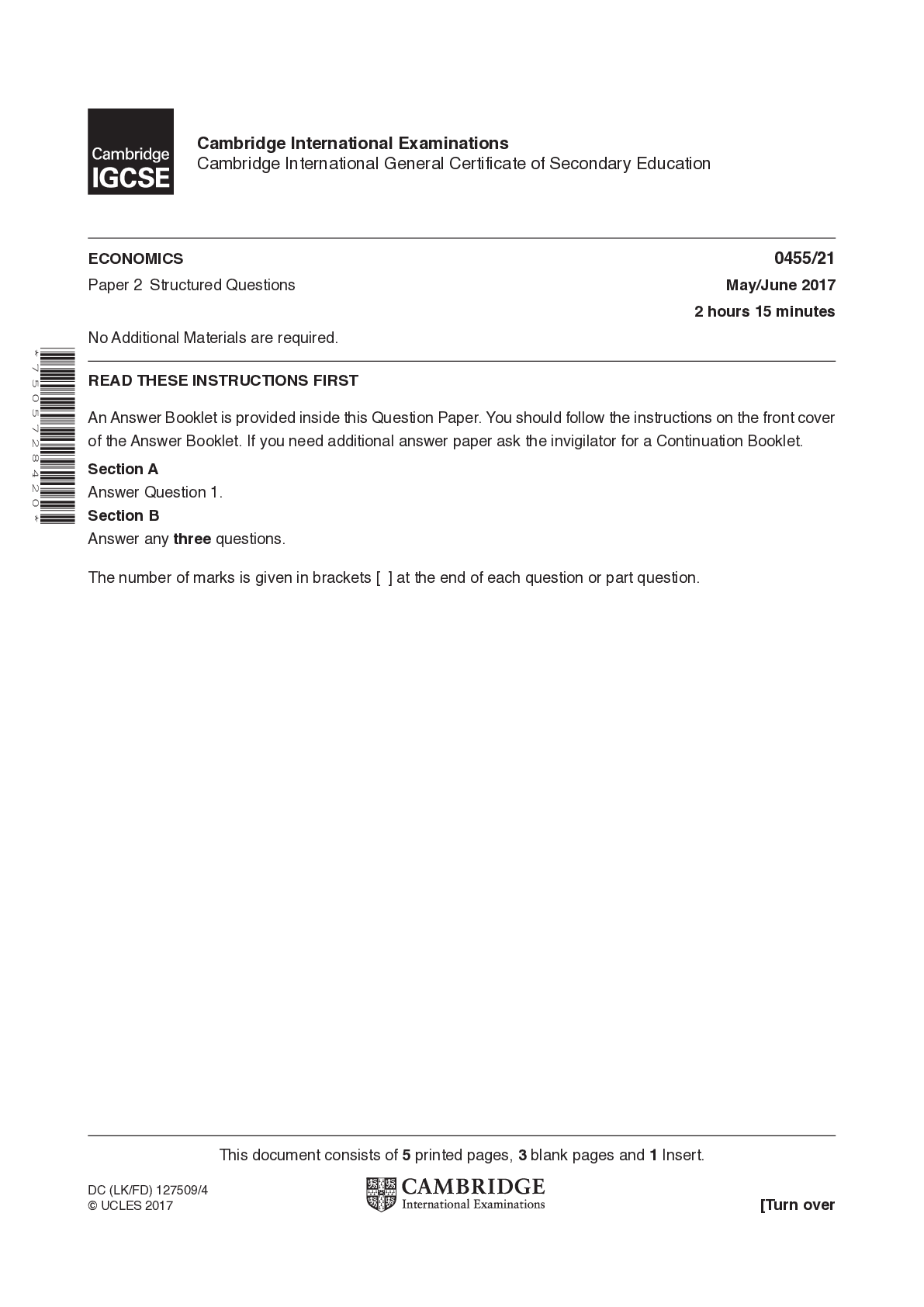
Buy this document to get the full access instantly
Instant Download Access after purchase
Add to cartInstant download
Reviews( 0 )
Document information
Connected school, study & course
About the document
Uploaded On
Jun 01, 2021
Number of pages
78
Written in
Additional information
This document has been written for:
Uploaded
Jun 01, 2021
Downloads
0
Views
70

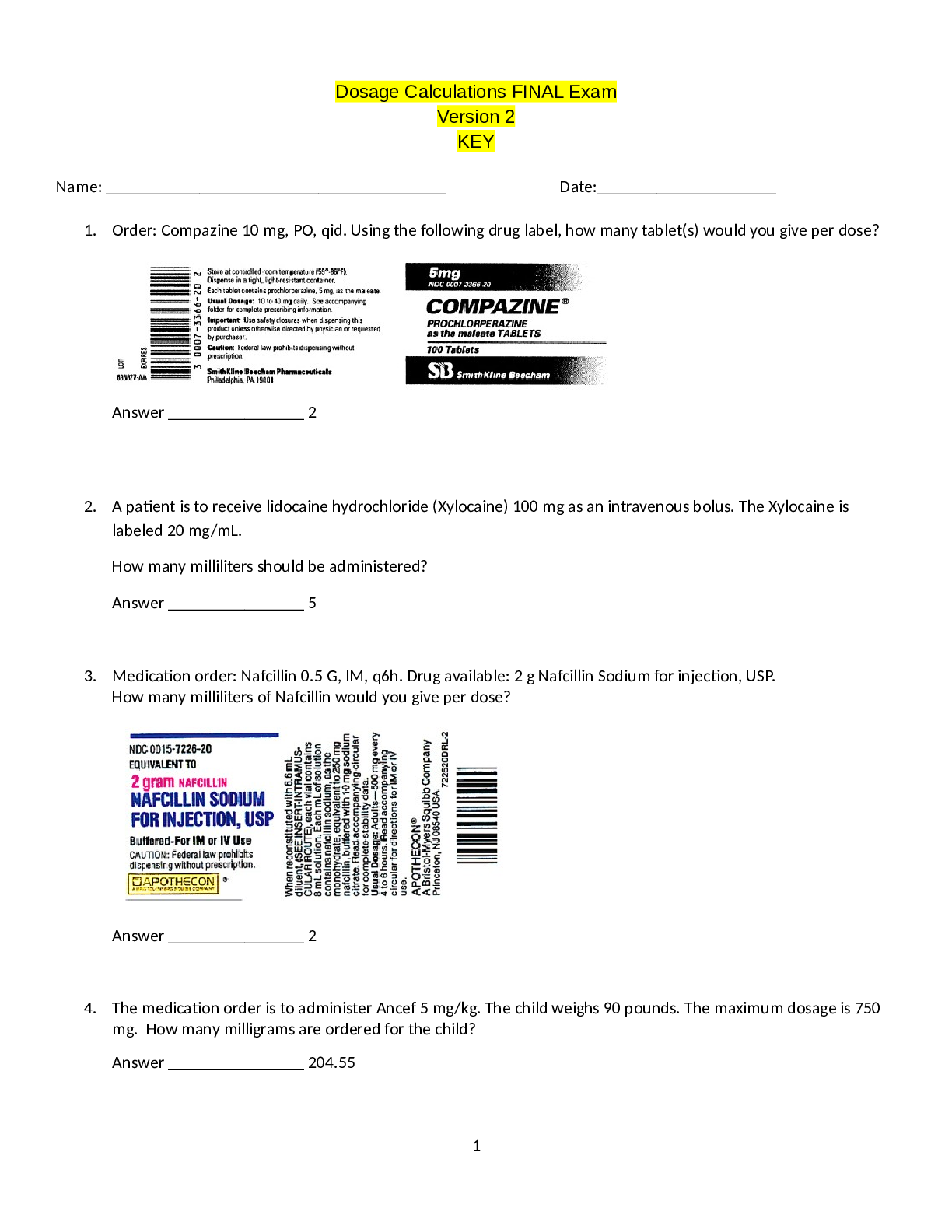


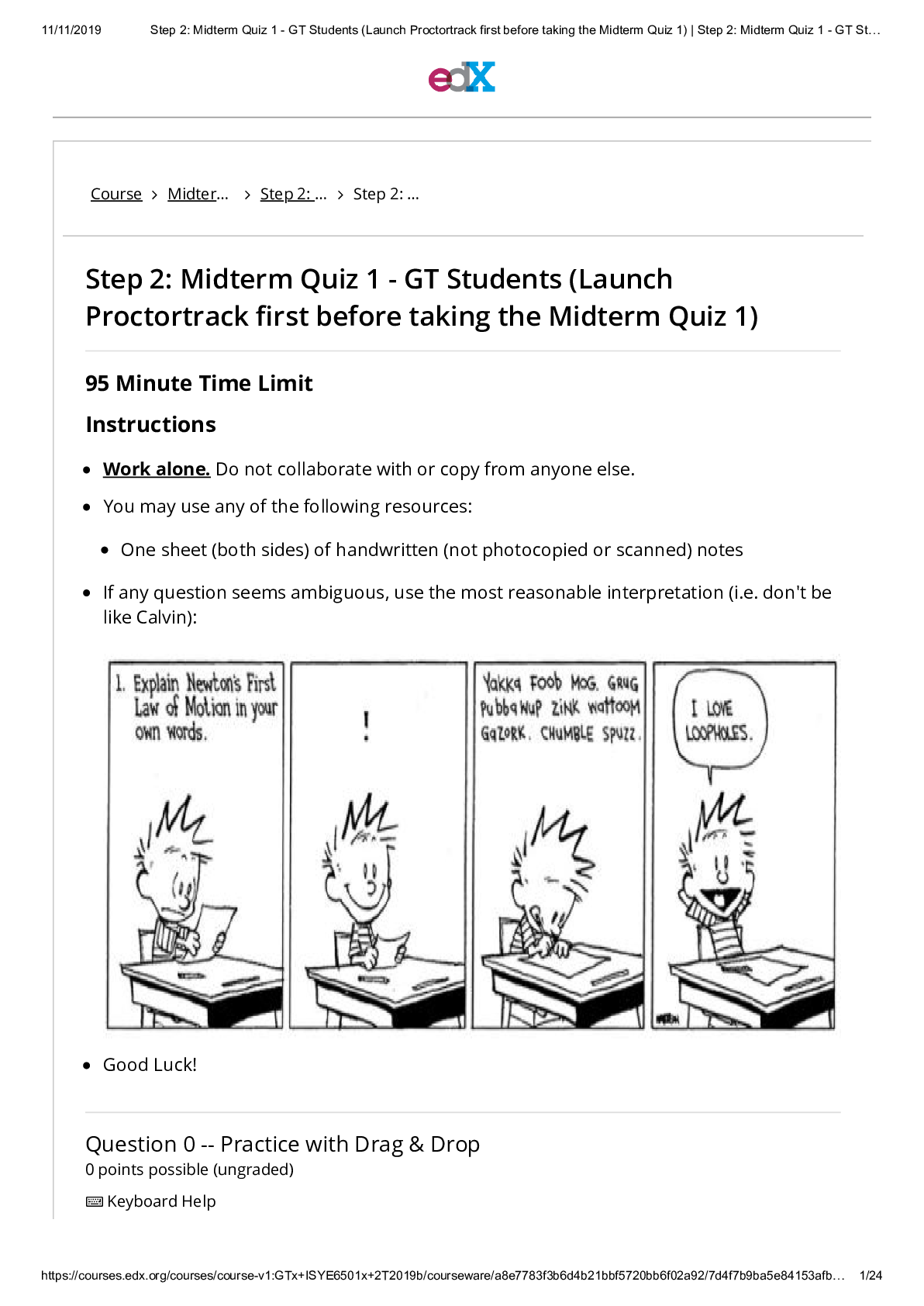

.png)
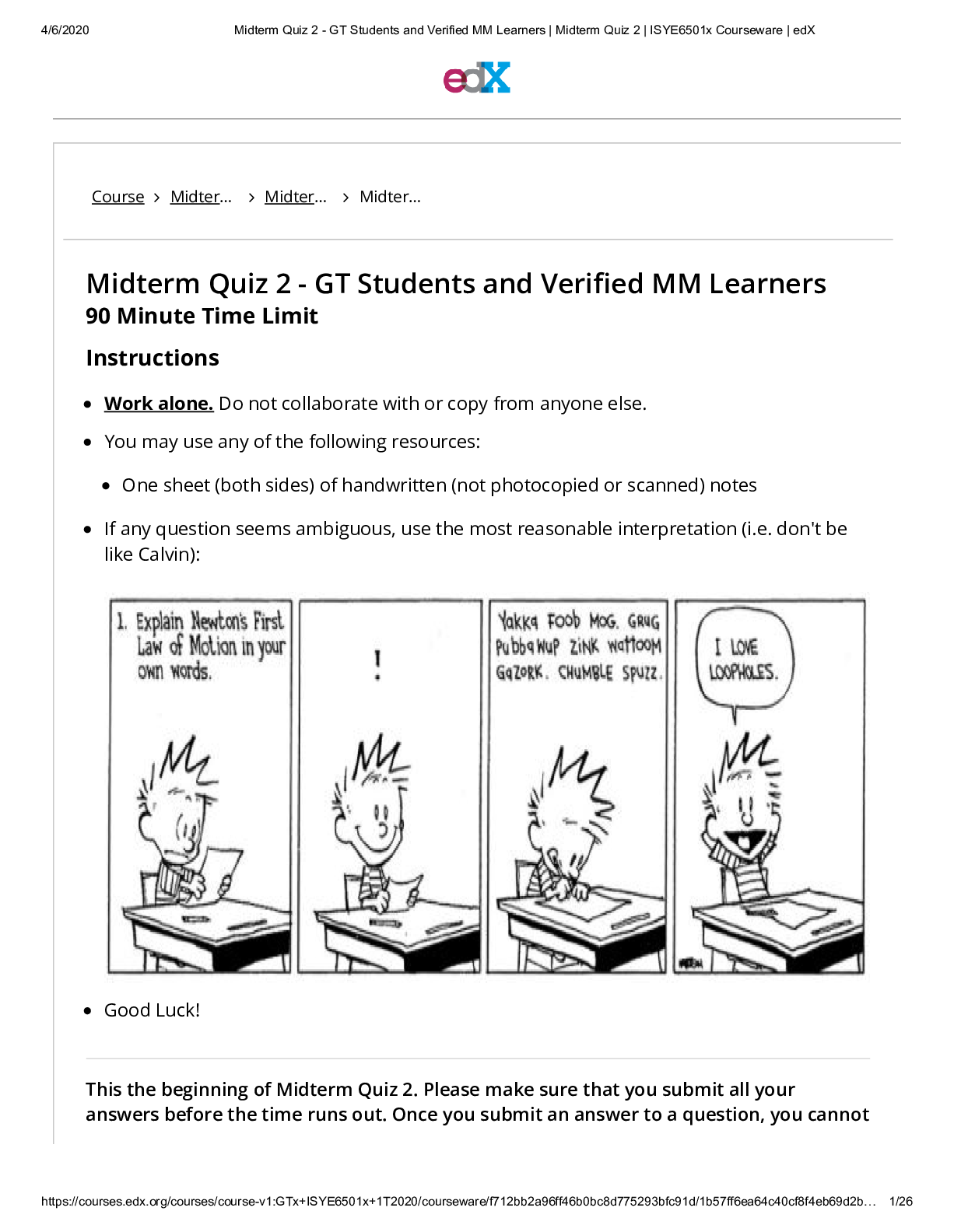






.png)
